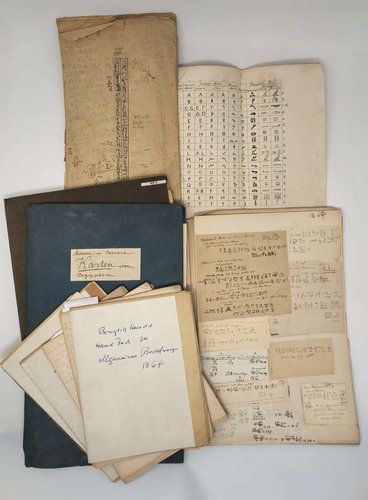




























#P99
1863-4
Sixty-nine pairs of mounted albumen stereoview photographs on card, each pair ca. 8x14 cm (3 x 5 ½ in) or slightly smaller. Fifteen cards with period ink captions in English or French and dates on versos (“1863” or “1864,” nine dates include months). Forty-two other cards with period manuscript captions in English and/or French on versos, some lengthy; over thirty captions with manuscript references to “Murray’s handbook.”. A few images mildly faded, but overall a very good collection of strong interesting photos.
An interesting early collection of Egyptian stereoviews with an evident connection to the Alexandria Waterworks, or Alexandria Water Company, which was founded in 1860 in order to manage the city’s water supply and sewerage. Eight photos (two identical) have captions referring either to “waterworks,” “etablissement des eaux,” or “Com-ed-Dik” (Kom Ad Dikah) hill and neighbourhood of Alexandria where the plant was located. Dated November-December 1863, the photos show the waterworks’ engine house, central court, one of the buildings under construction, and two views of “Village de Com-ed-dic, vue prise du reservoir.” Of the nineteen other photos, not directly captioned as taken in the waterworks, eight are dated November 1863 – February 1864 in the same or similar hand (portraits of “Mons. Goifont”(?), Egyptian boy “Massaout,” “Mr. Moses Meredith,” and a Caucasian family with a baby), and at least seven depict the same or similar landscapes and buildings (Kom Ad Dikah neighbourhood, general view of the waterworks with the distinctive engine house, two group portraits of European men and three portraits of Egyptian servants posing in front of the same building as on the captioned photos). The photographs were likely taken or assembled by a British or French associate of the Alexandria waterworks who photographed his place of work and also went on a cruise up the Nile to see the Egyptian antiquities.
Egyptian cities and ancient sites are shown on forty-two stereoviews, most of which have extensive manuscript notes on versos, as well as accurate references to the famous “Handbook for travellers in Lower and Upper Egypt” issued by John Murray (1st ed. in 1847, the 11th edition in 1907).
The photos show Alexandria (general view, Grand Square, Cleopatra’s Needle, Pompey’s Pillar); Cairo (general view, the Citadel, the Tombs of the Caliphs, Uzbekeeh Square, “garden near the Oriental Hotel,” Bulaq neighbourhood taken from the Nile, interior of the Mosque of Sultan Barquq); Pyramids of Giza (the Great Pyramid, the Sphinx, general view of the complex, “El Kafr, village near the Pyramids”); Karnak Temple (general views, statues of goddess Pacht, Avenue of Sphinxes, Great Hypostyle Hall); Thebes and environs (temple in Hermonthis/Armant, “temple-palace at Old Koorneh,” Luxor, Colossi of Memnon, Ramesseum, Tombs of the Kings); temples in Medinet Habu, Edfu, Kom Ombo, Abu Simbel and Dakka (in its original state, before it collapsed in 1908-9, was rebuilt by Alessandro Barsanti, and relocated in the 1960s during the construction of the Aswan High Dam); Aswan and environs (Philae Island and temple, Biggeh/ Elephantina Island, Nile at the site of Aswan); Djebel-Silsileh (Gebel el-Silsila) mountains and famous quarries between Edfu and Kom Ombo. Overall an interesting extensive collection of early unusual stereoviews of Egyptian ancient and modern sites.
“The city [Alexandria] was provided with gas in 1865, and is also now well supplied with water. The old cisterns, the number of which is said still to exceed a thousand, and the situation of which enables us to determine the direction of the ancient streets, have been superseded by the modern waterworks, completed in 1860, which are supplied by the Moharrem-Bey Canal, a branch of the Mahmudiyeh Canal. The reservoir, into which the water is pumped by steam, after having been filtered, is situated on the top of the Kom ed’Dik hill, the site of the Paneum of antiquity, and is capable of containing 10,000 cubic metres of water (about 360,000 cubic feet). The water-rate per cubic meter (36 cubic feet) is now 1 fr. Only, while for the same quantity the old water-carriers used to receive 2 fr. 25 c.” (Baedeker, K. Egypt: Handbook for Travellers. Part 1. Leipzig & London, 1885, p. 216).




































